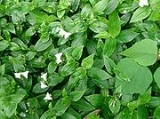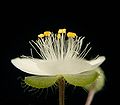
Tradescantia fluminensis
Encyclopedia
Tradescantia fluminensis is a species of spiderwort native to South America. It is one of several plants known by the common name Wandering Jew
. It is also known as River Spiderwort, Small-Leaf Spiderwort, Inch Plant, Wandering Trad and Wandering Willie.
T. fluminensis is a perennial ground cover that spreads along the ground with soft, hairless stems and leaves. The fleshy stems root at any node that is on the surface. The plant has oval, dark-green leaves with pointed tips that are shiny, smooth and slightly fleshy about 1.25 - 2.5 inches long. The flowers are white with three petals and approx. 0.5 - 1 inch in diameter. They are produced in small clusters in summer but do not produce seeds.
plant or houseplant
in many places. This is particularly true of the northern United States
but even in places where it is a pest it may be grown as a house plant in variegated forms. The plant requires a moist soil to do well but is retarded by cold climates, especially where there is frost or snow. It tolerates heavy shade. Because it requires moisture it grows weakly, if at all, in sunny areas that dry out for long periods. However, because it is a fleshy plant that retains water, it can withstand extended periods of dryness only to resume growth once better conditions return.
, noxious weed
, or pest plant in many places and is consequently targeted for eradication. Seriously affected areas include Australia
, New Zealand
, and the southeastern United States.
 The seriously invasive qualities of T. fluminensis result from a combination of attributes. Forming a dense mat underneath forest
The seriously invasive qualities of T. fluminensis result from a combination of attributes. Forming a dense mat underneath forest
tree
cover to 12 inches (30 centimeters) or even more (facilitated by a remarkable shade tolerance) it smothers ground-level plants and prevents the natural regeneration of taller species and if left unchecked, it can lead to the destruction of native forests. Even where the climate
does not permit T. fluminensis to take root
, it still can spread rapidly from being transported by animals and humans and even strong winds. The succulent stems
break easily at the nodes and establish themselves wherever they land on moist soil
. While T. fluminensis does respond to herbicide
s and other applied weed controls, each segment has the ability to regenerate
, so it is able to make a rapid comeback, especially in soft soils where stems may remain underneath the surface.
Successful treatments include the following:
 Chemical treatment will result in browning off in 3-4 weeks followed by disappearance of living material. However, follow-up is needed several months later (in a frost free climate) to catch any buried plant segments that may have regenerated and possibly a third such spot treament is required before the area is completely eradicated and even after that attention to a resurgence is advised.
Chemical treatment will result in browning off in 3-4 weeks followed by disappearance of living material. However, follow-up is needed several months later (in a frost free climate) to catch any buried plant segments that may have regenerated and possibly a third such spot treament is required before the area is completely eradicated and even after that attention to a resurgence is advised.
Wandering Jew (disambiguation)
The Wandering Jew is a character from Christian folklore.Wandering Jew can also refer to:* Le Juif Errant , an 1844 novel by Eugène Sue...
. It is also known as River Spiderwort, Small-Leaf Spiderwort, Inch Plant, Wandering Trad and Wandering Willie.
T. fluminensis is a perennial ground cover that spreads along the ground with soft, hairless stems and leaves. The fleshy stems root at any node that is on the surface. The plant has oval, dark-green leaves with pointed tips that are shiny, smooth and slightly fleshy about 1.25 - 2.5 inches long. The flowers are white with three petals and approx. 0.5 - 1 inch in diameter. They are produced in small clusters in summer but do not produce seeds.
Cultivation
T. fluminensis is grown as a gardenGarden
A garden is a planned space, usually outdoors, set aside for the display, cultivation, and enjoyment of plants and other forms of nature. The garden can incorporate both natural and man-made materials. The most common form today is known as a residential garden, but the term garden has...
plant or houseplant
Houseplant
A houseplant is a plant that is grown indoors in places such as residences and offices. Houseplants are commonly grown for decorative purposes, positive psychological effects, or health reasons such as indoor air purification...
in many places. This is particularly true of the northern United States
United States
The United States of America is a federal constitutional republic comprising fifty states and a federal district...
but even in places where it is a pest it may be grown as a house plant in variegated forms. The plant requires a moist soil to do well but is retarded by cold climates, especially where there is frost or snow. It tolerates heavy shade. Because it requires moisture it grows weakly, if at all, in sunny areas that dry out for long periods. However, because it is a fleshy plant that retains water, it can withstand extended periods of dryness only to resume growth once better conditions return.
Invasion as a Pest
T. fluminensis is considered an invasive speciesInvasive species
"Invasive species", or invasive exotics, is a nomenclature term and categorization phrase used for flora and fauna, and for specific restoration-preservation processes in native habitats, with several definitions....
, noxious weed
Weed
A weed in a general sense is a plant that is considered by the user of the term to be a nuisance, and normally applied to unwanted plants in human-controlled settings, especially farm fields and gardens, but also lawns, parks, woods, and other areas. More specifically, the term is often used to...
, or pest plant in many places and is consequently targeted for eradication. Seriously affected areas include Australia
Australia
Australia , officially the Commonwealth of Australia, is a country in the Southern Hemisphere comprising the mainland of the Australian continent, the island of Tasmania, and numerous smaller islands in the Indian and Pacific Oceans. It is the world's sixth-largest country by total area...
, New Zealand
New Zealand
New Zealand is an island country in the south-western Pacific Ocean comprising two main landmasses and numerous smaller islands. The country is situated some east of Australia across the Tasman Sea, and roughly south of the Pacific island nations of New Caledonia, Fiji, and Tonga...
, and the southeastern United States.

Forest
A forest, also referred to as a wood or the woods, is an area with a high density of trees. As with cities, depending where you are in the world, what is considered a forest may vary significantly in size and have various classification according to how and what of the forest is composed...
tree
Tree
A tree is a perennial woody plant. It is most often defined as a woody plant that has many secondary branches supported clear of the ground on a single main stem or trunk with clear apical dominance. A minimum height specification at maturity is cited by some authors, varying from 3 m to...
cover to 12 inches (30 centimeters) or even more (facilitated by a remarkable shade tolerance) it smothers ground-level plants and prevents the natural regeneration of taller species and if left unchecked, it can lead to the destruction of native forests. Even where the climate
Climate
Climate encompasses the statistics of temperature, humidity, atmospheric pressure, wind, rainfall, atmospheric particle count and other meteorological elemental measurements in a given region over long periods...
does not permit T. fluminensis to take root
Root
In vascular plants, the root is the organ of a plant that typically lies below the surface of the soil. This is not always the case, however, since a root can also be aerial or aerating . Furthermore, a stem normally occurring below ground is not exceptional either...
, it still can spread rapidly from being transported by animals and humans and even strong winds. The succulent stems
Plant stem
A stem is one of two main structural axes of a vascular plant. The stem is normally divided into nodes and internodes, the nodes hold buds which grow into one or more leaves, inflorescence , conifer cones, roots, other stems etc. The internodes distance one node from another...
break easily at the nodes and establish themselves wherever they land on moist soil
Soil
Soil is a natural body consisting of layers of mineral constituents of variable thicknesses, which differ from the parent materials in their morphological, physical, chemical, and mineralogical characteristics...
. While T. fluminensis does respond to herbicide
Herbicide
Herbicides, also commonly known as weedkillers, are pesticides used to kill unwanted plants. Selective herbicides kill specific targets while leaving the desired crop relatively unharmed. Some of these act by interfering with the growth of the weed and are often synthetic "imitations" of plant...
s and other applied weed controls, each segment has the ability to regenerate
Regeneration (biology)
In biology, regeneration is the process of renewal, restoration, and growth that makes genomes, cells, organs, organisms, and ecosystems resilient to natural fluctuations or events that cause disturbance or damage. Every species is capable of regeneration, from bacteria to humans. At its most...
, so it is able to make a rapid comeback, especially in soft soils where stems may remain underneath the surface.
Chemical Control
The plant is resistant to chemical control as a result of its glossy leaves and smooth stems, along with its ability to regenerate from small surviving pieces. Nevertheless, for large infested areas this is probably the only means of achieving control. Unfortunately, any chemical that is capable of killing the plant is likely to kill most other plants and so a clear area will result for a period of time. However, since there are treatments that rapidly degrade upon soil contact within a day, this effect is limited to the time that it takes for seeds of other species to germinate and establish themselves. Because of the waxy surface of leaves and stems, a penetrant is needed for effective treatment.Successful treatments include the following:
- triclopyr (marketed under various brand names) plus a penetrant such as the organosilicone called modified polydimethylsiloxane (e.g. Pulse)

Manual Control
Repeated deployment of weed-control agents may have a negative effect upon the local environment, in which case the only option remaining is manual clearance. In areas where the plant is a pest this is an arduous task since every single scrap of the weed has to be removed or it will regrow. In less prolific areas, manual removal is less difficult as the plant roots come up easily, and an initial clearance can be accomplished by raking the area. Repeated efforts at intervals of a few months along with regular monitoring for invasion from neighbouring areas will be necessary for full control.Combined Chemical/Manual Control
In view of the persistance of the plant and the cost of chemical treatment plus the negative effect on other species, especially in regions where it is a pest, a combination of an initial chemical treatment followed by manual removal for the second or possibly third treatment is worth considering. Nevertheless, absolutely scrupulous attention to the removal of every single piece of the stems from both above and below the surface is required before elimination can be assured.External links
- Standard Data Report: Tradescantia fluminensis - Integrated Taxonomic Information System
- PLANTS Profile: Tradescantia fluminensis - National Resources Conservation Service (US Department of Agriculture)
- Taxonomy Browser: Tradescantia fluminensis - National Center for Biotechnology Information (US National Institutes of Health)
- Desert Tropicals - Informational database on common gardening plants, based out of Phoenix, Arizona, USA
- Dave's Garden - Community website for home gardeners providing supplies, techniques, and discussion forums.

